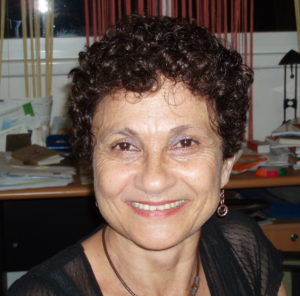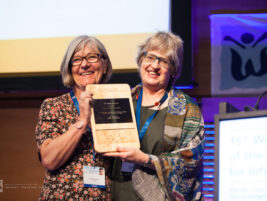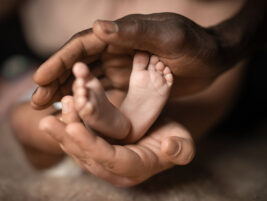About the International Attachment Conference, Braga, Portugal (11.-13.7.2007)

If one ever wished to see and hear the main attachment researchers and clinicians under the same roof…he/she should have come to Braga and the Minho University this last summer. For those who couldn’t, here are some highlights that struck me the most (obviously this is not a comprehensive summary of the conference). Indeed, this conference, jointly organized by Isabelle Soares from the University of Minho (Portugal) and her team, and Klaus and Karin Grossman from the University of Regensburg (Germany), was special in its diversity of points of view about the concept and diagnosis of attachment disorders. Isabelle Soares’s lecture about “Changing troubled attachment relationships: From theory, research, and clinic”, started with reminding listeners of Bowlby’s view of the five main therapeutic tasks: establishing a secure base, exploring past attachments, exploring the therapeutic relationship, linking past experiences to present ones, and revising internal working models. Observation of attachment behaviors include not only the SSP, but also Alan Sroufe’s AMBIANCE tool for assessing problem-solving toddlerhood. She emphasized the main attachment-based interventions, including the Circle of Security, STEP, Attachment-based intervention for foster and adoptive parents, and the Early Bucarest intervention. Jay Belsky (Birbeck Univ. of London, UK) then presented surprising data from his Early Child Care Study: he found that family factors and processes were more consistent in predicting socio-emotional development than child day care factors…for the good and for the bad. The effects – positive as negative – of the day care on infants, were modest, if not small. Low sensitive maternal care was the variable that made the difference between the children who had more than 10 weeks of daycare per week versus those who had nore than 30 hours of daycare per week. Belsky concluded with two very important messages: (1) Small effects that impact many individuals may be more dangerous for society than large effects that impact few individuals. (2) The common clinical practice to send infants from multirisk families to daycare in order to decrease the infants’ exposure to inadequate maternal behaviors, is probably less efficacious than we would like to think.
Thomas O’Connor’s (Univ. of Rochester, USA) lecture was extremely interesting and provocative: “The early care experience case in humans is not yet proven”‘ he claimed, meaning that we need a more evidence-based assessment of what we call attachment disorders. For instance, do post-institutionalized adopted children who still show a disinhibited pattern ( meaning a tendency to go to strangers) at age 11 still meet the diagnosis of attachment disorder, in spite of their being clearly differentially attached to their adoptive parents? (By the way, this pattern was seen in 255 of the children who had been adopted after the age of 6 months, as compared to 10% in those adopted before 6 months of age). How to explain the finding that some of the institutionalized children do show a secure attachment pattern? In animals, it was shown that maternal insensitivity did matter when it was associated with a certain genetic pattern. It seems that neuroendocrine factors are also at play. O’Connor concluded with the need to formulate a “more nuanced model of the impact on early deprivation in humans”, to refine our assessment process of attachment disorders, so that we can make a better differentiation between relationships disorders and attachment disorders, and consequently, to better define the treatment goals when we face very deprived infants before and after adoption.
The second day of the conference addressed intervention issues. Mary Dozier’s colleague (Univ. of Delaware, USA) presented recent research and intervention findings related to foster parents and attachment. Again the notion of critical age of adoption/placement, was raised: infants placed before the age of one year (not six months, as reported by O’Connor) showed secure behaviors within two weeks if placed with a secure caregiver, as opposed to those who were placed after one year of age and showed insecure patterns across the first two months after placement. Their additional finding that foster-care infants often become disorganized when the foster parent is insecure and not necessarily disorganized (as opposed to the usual pattern of transmission Unresolved to Disorganized in biological dyads, stresses the importance of having secure foster parents, or at least providing them attachment-focused interventions. An additional very interesting finding, this time related to biology and behavior, was about the abnormal cortisol levels in half of their foster children, and its potential significance in terms of vulnerability for later psychopathology. Their most recent study is the comparison between their 10-sessions attachment intervention and cognitive intervention with foster parents, while one of their outcome measures that is the foster infant’s cortisol level.
Miriam Steele (New School, NY, USA) presented her astonishing data about changes in attachment representations in adoptive children(4-8 year olds) who were previously maltreated, comparing early and late adoption. Her main findings stress again the importance of the adoptive parent’s own security of attachment, and the father’s role in buffering the mother’s insecurity: regardless of the parents’ attachment classification, all the children showed an increasing amount of secure elements, but themes of aggression, disorganization, and defensive avoidance of maltreated children did not change when the adoptive parents were insecure. It seems that, as Bowlby had already predicted, that insecure parents find the child’s negative emotions too hard to deal with, and therefore cannot make reparation of “interactive errors” (Edward Tronick’s term). By the way, contrary to our intuitive thinking, the number of previous caregivers before adoption did not correlate with the children’s prognosis.
Robert Marvin, (Univ. of Virginia, USA) with his usual enthusiasm, presented a further elaboration of the “Circle of Security” intervention, named “Circle of Repair”, that specifically defines what the difficult young child needs from the parent in times of frustration and temper tantrums (Take charge of me, Be kind with me, Soothe me, Stay with me, Help me to return to what I was doing, with a new option…); He also developed the “Circle of Limited Security” for the miscuing child, , which is actually tailored for high risk foster/adopted children: “I need you to welcome my coming to your home, but that makes us uncomfortable because I come from a “rejecting dance circle” and you may have a difficult history of your own. Therefore I send you a false signal, being an “as if” exploratory behavior or an “as if” distant behavior”. Cues and miscues are the main target of intervention for these dyads (as Mary Dozier has concretized in her manualized attachment intervention).
Martha Erickson (Univ of Minnesota, USA) presented her well-known STEEP model of intervention. This model, is, I think, an example of the creativity and flexibility that make the infant mental health work a special art, as a parallel process to what makes a good-enough parenting. Prenatal home visits, video use, parent-infant groups, family nights with fathers’ involvement, they are all there, and their positive impact on outcomes of 154 high risk parents and infants, has been proven. Martha emphasized the ongoing need to “train the trainer”, while “the biggest challenge lies in the space between what we know and what we do”.
Robert Pianta (Univ. of Virginia, USA) presented approaches aimed at improving the quality of relationships between teachers and children, and stressed the important role that schools may/should have in enhancing children’s social outcomes.
oger Kobak (Univ. of Delaware, USA) addressed the topic of adolescent attachment, while asking the very pertinent question of the link between the adolescent’s state of mind as reflected in the AAI, and the adolescent’s attachment status, as reflected in conflict discussion and negotiation tasks. He reported his study of 225 caregivers and adolescents, and shared with us the following findings that support his concept of the “Dual model”: Caregiver’s insecurity plus unresolved loss is the combination that impact on the adolescent. Caregiver’s insecurity plus unresolved abuse have a much stronger impact on the adolescent’s chance to have dissociative and depressive symptoms. Security of attachment at age 13 predicted increased level of empathy and decreased level of externalizing problems; Role reversed attachment predicted increased behavior problems at age 15 in boys only, and disorganized attachment at 13 predicted increased internalizing behavioral problems at 15 years. Roger addressed also the issue of the teacher’s role for the adolescent, and suggested to enhance the teachers’ reflective functioning with videotape-based training.
Elisabeth Carlson (Univ of Minnesota, USA) presented her research on attachment disorganization and disorder, that supports her notion that the difference between the two is mainly a matter of degree.
Howard Steele (New School University, NY, USA) presented the London Parent-Child project that looked at intergenerational patterns of attachment from pregnancy in one generation in the next. Here are some of their interesting findings: the 11 year old child’s ability to coherently acknowledge distress and elaborate a resolution, was correlated with secure mother’s attachment (The Friends and Family Interview, Steele and Steele, 2004 in Attachment in Middle Childhood). They found a relatively low stability from infancy to adolescence, high understanding of mixed emotions at the Affect Task at six years of age, predicted whom children would be secure at adolescence and showed good mental health. Mental health at 16 years was correlated with mother’s secure AAI during pregnancy. I thought it interesting to note that fathers’ view of the marriage when the child was six years old, was correlated with the adolescent’s AAI.
Carole George (Mills College, USA) described her Adult Attachment Projective (AAP) tool for assessing traumatic attachment dysregulation in adults. In her experience, this tool is much easier to administer and to code than the AAI. The stimuli used to trigger attachment representations are picture drawings of attachment events put on a range of intensity (ball, child at window, departure of adult from adult, bench, bed, ambulance, cemetery, child in corner…). The adult is asked to tell a story about the pictures, through which agency of self, relationships with others, and defensive processes are assessed. The themes that appear in traumatic dysregulation, include violence in relationships, in the environment, abandonment, murder, suicide, wish to become invisible/to disappear, and characters in fetal position. An astonishing link has been shown between these themes, especially the item of being alone as being the most terrifying situation, and activation of the hippocampus, the amygdala and the prefrontal cortex in functional MRI. Carol George mentioned the work of Hobson et al. (2005) that provide insight into the dynamics of Borderline personality disordered mothers’ interactive and emotional breakdown with their infants, and have significant clinical applications. The AAP analysis is similar to AAI coding system, can be used in individual and couple therapies, but also with parents of teens for understanding better their “tough teen”.
Karen Lyons-Ruth(Harvard Medical School, USA) continued the topic of borderline adult personality disorder, as she found it linked with disorganized and controlling forms of attachment in late adolescence. Severity of abuse, genetic vulnerability to stress (presence of the short form of serotonin transporter promoter polymorphism 5-HTTLPR), and early (meaning during infancy) referral to mental health services were the three predictors of borderline personality disorders among the children she followed from infancy to young adulthood. Borderline personality disorder was especially linked with maternal withdrawal relational pattern (this finding may remind some of us about the classical psychoanalytical concept of the Dead mother, introduced by Andre Green in France many years ago…).
I must confess I did not attend the last two lectures, presented by Jude Cassidy and Nicole Guedeney respectively, because my exploratory system pulled me out of Minho University to Porto, before going back to Israel!
To conclude, this conference, in my eyes, was special in the way it integrated very updated data of various top researchers in the field of attachment, each one of them bringing up different aspects of attachment, ranging from biological topsychological, from infancy to adulthood, in community as well as in clinic, and at home as well as at school.
Authors
Miri Keren, M.D.
Editor, The Signal
Israel








